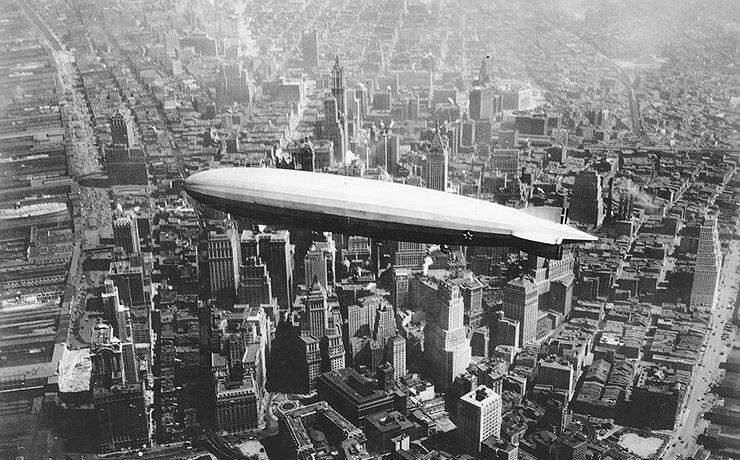
 With a length of 803.8 feet, it was a massive airship, only 80 feet shorter than the 1912-sunk, ocean-liner Titanic.
With a length of 803.8 feet, it was a massive airship, only 80 feet shorter than the 1912-sunk, ocean-liner Titanic.
Along with its sister craft, the LZ-130, the LZ-129 Hindenburg was the largest-man-made object to ever fly.
In the summer of 1936, the Hindenburg flew over Lake George, New York while heading south to its destination at Lakehurst, New Jersey. Less than a year later, the airship mysteriously caught fire and crashed while docking at the Lakehurst Naval Air Station. Thirty-six people died in the tragedy. Photographs and motion picture film captured the horrific event for a pre-World War II generation.

 The Hindenburg, named after a president of Germany, was built in 1936 for trans-Atlantic travel. It was conceived from a line of German airships known as Zeppelins.
The Hindenburg, named after a president of Germany, was built in 1936 for trans-Atlantic travel. It was conceived from a line of German airships known as Zeppelins.
The first Zeppelin, designated LZ-1 (Luftschiff Zeppelin-1), was 430 feet long and was completed in 1899. The design was simple and was employed by Germany for years, a cigar-shaped rigid metal frame containing individual gas cells covered by fabric material.
The dirigible was the brainchild of Count Ferdinand von Zeppelin (1838–1917), a German general. He came to America to observe the Civil War (1861–1865). In 1863, he first experienced lighter-than-air flight from a hot-air balloon used by the United States army to observe Confederate defenses.
After building numerous airships, Zeppelin died in 1917. His successor to dirigible construction was Hugo Eckener (1868–1954). He constructed many airships and after Hitler’s rise to power in the 1930s, Eckener often got into squabbles with Hitler’s German government. Eckener opposed displaying the Nazi symbol on his airships’ tails.

 The Hindenburg made its inaugural flight in March 1936. Several months later, it was flying from Germany to Canada and then on to Lakehurst in New Jersey. On the evening of July 1, 1936, the Hindenburg traveled from Montreal south to the Garden State.
The Hindenburg made its inaugural flight in March 1936. Several months later, it was flying from Germany to Canada and then on to Lakehurst in New Jersey. On the evening of July 1, 1936, the Hindenburg traveled from Montreal south to the Garden State.
At 11:05 pm on July 1, the Hindenburg flew over Plattsburgh, New York and continued along Lake Champlain passing over Ticonderoga at 11:35 pm. Twenty minutes later at 11:55 pm it was over Bolton Landing. At 12:02 am on July 2, the Zeppelin was visible from Glens Falls.
Newspapers reported it traveled at 100 mph. However, the Hindenburg generally cruised at around 76 mph.
Many people who knew about the flight stayed up to view the gargantuan dirigible. They reported seeing a taillight and three running lights as well as illumination from the cabin. The Hindenburg’s four Daimler-Benz diesel engines were heard, too.

 For one summer resident, Emma Beckers, who lived with her husband, Dr. William Beckers, in the Villa Marie Antoinette on the Bolton Road in the Town of Bolton, there was reason to observe the Hindenburg. Her German-born husband, who became an American citizen, was a friend of Hugo Eckener, the airship’s designer.
For one summer resident, Emma Beckers, who lived with her husband, Dr. William Beckers, in the Villa Marie Antoinette on the Bolton Road in the Town of Bolton, there was reason to observe the Hindenburg. Her German-born husband, who became an American citizen, was a friend of Hugo Eckener, the airship’s designer.
At the time, Dr. Beckers was in New York City to greet friends traveling from Germany aboard the dirigible. The Ballston Spa Daily Journal reported that earlier in 1936, Dr. Beckers had crossed the Atlantic Ocean from Germany to America in the Hindenburg.
On August 1, 1936, a month after the Hindenburg journeyed over Lake George, the gigantic Zeppelin flew over the Berlin Olympic Games, a propaganda victory for Hitler.

 On May 6, 1937, the Hindenburg unexpectedly caught fire and crashed at Lakehurst, New Jersey. The blaze, whose cause is still debated, effectively ended trans-Atlantic dirigible flight for passengers.
On May 6, 1937, the Hindenburg unexpectedly caught fire and crashed at Lakehurst, New Jersey. The blaze, whose cause is still debated, effectively ended trans-Atlantic dirigible flight for passengers.
However, for several minutes in the evening of July 1, 1936, the king of airships flew over the “Queen of American Lakes.”
A version of this article first appeared on the Lake George Mirror, America’s oldest resort paper, covering Lake George and its surrounding environs. You can subscribe to the Mirror HERE.
Illustrations, from above: The USS Los Angeles, a United States Navy airship built in Germany by the Luftschiffbau Zeppelin (Zeppelin Airship Company); Ferdinand von Zeppelin in Virginia, June 1863 (National Archives); Hindenburg’s Dining Room (Airships.net collection); an historic marker at the former residence in Bolton Landing of Emma and Dr. William Beckers (John Farrell) and Hindenburg on fire at Lakehurst, New Jersey, on May 6, 1937 (Sam Shere).









Recent Comments